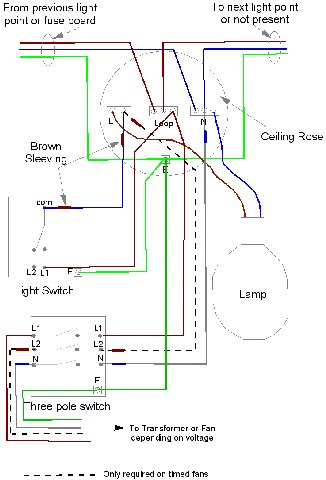- Details
There are two types of Radial circuit used for Sockets, Type A2 which uses 4mm² CSA Twin & Earth fused at 30A or 32A covering a floor area of 75m², and Type A3 which uses 2.5mm² CSA Twin & Earth fused at 20A covering a floor area of 50m². As with Ring circuits, there is no limit as to the amount of sockets that can be fitted to a Radial circuit. Your only limit is the length of cable.
OLD COLOURS
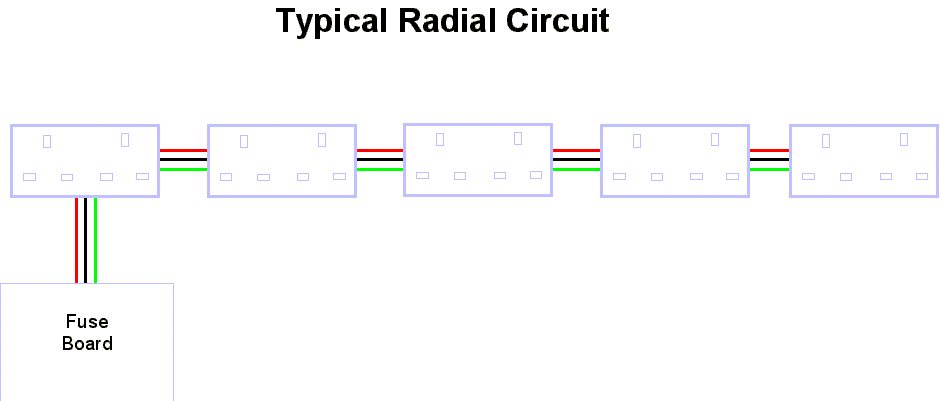
Click on image to enlarge
(It will open in a new window)
REMEMBER GREEN REPRESENTS GREEN/YELLOW CONDUCTOR IDENTIFICATION
NEW COLOURS
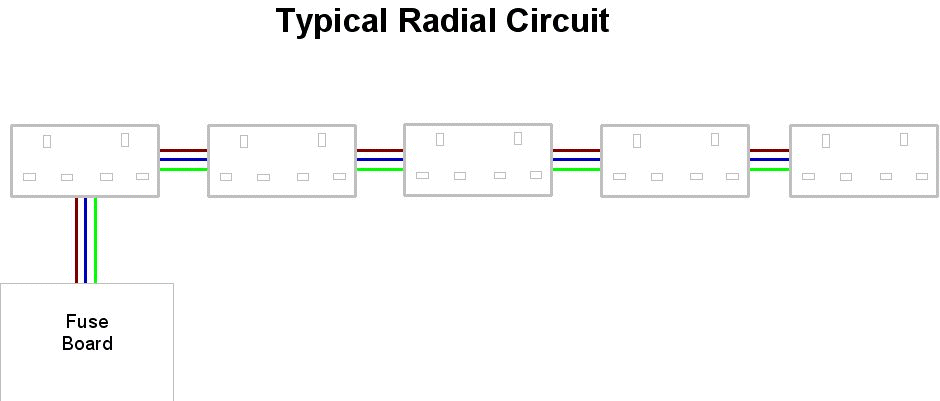
Click on image to enlarge
(It will open in a new window)
REMEMBER GREEN REPRESENTS GREEN/YELLOW CONDUCTOR IDENTIFICATION
There is no limitations on the amount of spurs that can be added to the circuit other than the length as previously mentioned.
OLD COLOURS
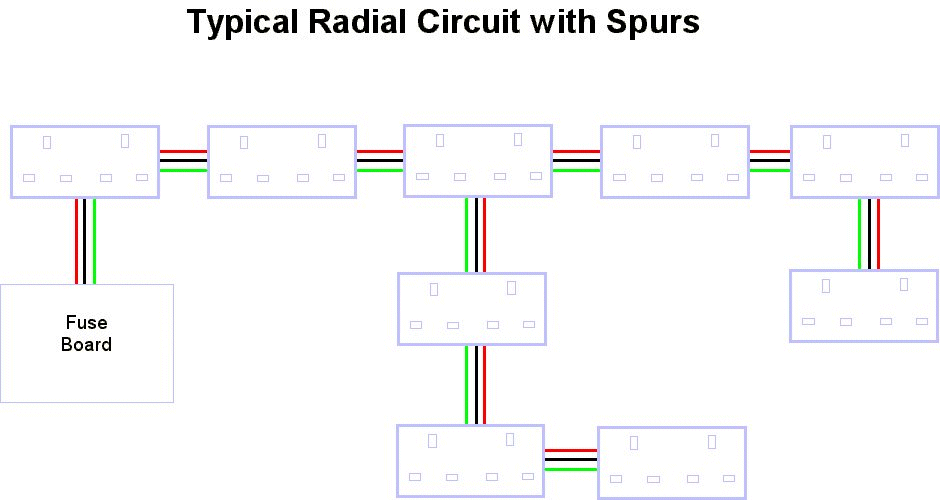
Click on image to enlarge
(It will open in a new window)
REMEMBER GREEN REPRESENTS GREEN/YELLOW CONDUCTOR IDENTIFICATION
NEW COLOURS
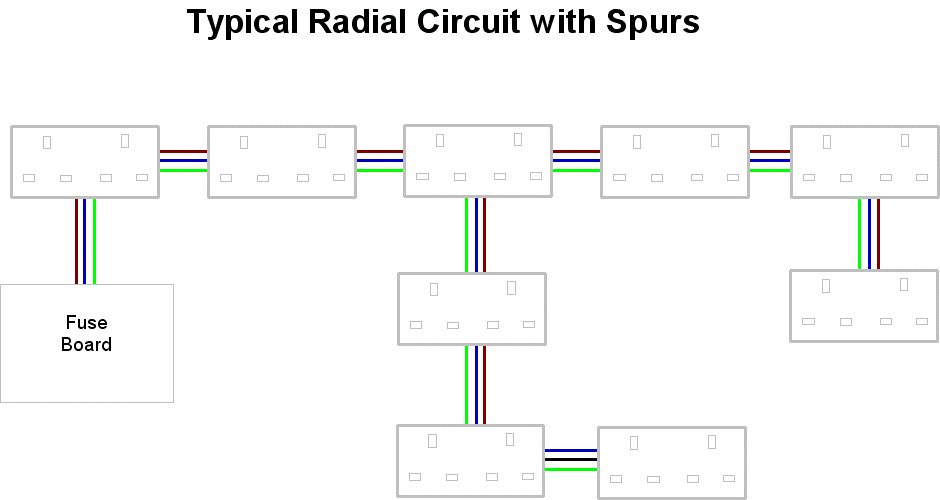
Click on image to enlarge
(It will open in a new window)
REMEMBER GREEN REPRESENTS GREEN/YELLOW CONDUCTOR IDENTIFICATION
- Details
The only Ring Circuit that you are likely to find in a domestic environment is that utilised by the sockets. The circuit is usually installed using 2.5mm² CSA Twin & Earth cable protected by a 30A MCB or re-wirable fuse or a 32A MCB. The cable leaves the fuse board and loops in and out of each socket and returns to the fuse board connecting to the same points in the fuse board as per the other end of the circuit. As many sockets as you like can form part of the ring circuit up to a maximum floor area of 100m². It is expected that a continuous current of 20A will be carried by the circuit and current in excess of this for short periods. Care should be taken with locating washing machines, dryers and dishwashers and spreading them out on the circuit. Consideration should also be given to providing a separate ring circuit for these appliances.
In older installations you will normally find a ring circuit supplying upstairs and another supplying downstairs. In modern installations it is normal to have an additional ring circuit to supply the kitchen, which is where one finds the heavier loads for, Kettles, Toasters, Washing Machines, Dishwashers, Grills etc. also in modern day ring circuits you will find the additional protection of an Residual Current Device (RCD). An RCD does not give overload protection like a fuse but gives quick protection if there should be a fault to earth, such as cutting a live cable or touching live parts. It is especially important to have one fitted to protect downstairs sockets where it could reasonably be expected to utilise them for portable equipment in the garden.
The diagram below shows a typical Ring Circuit
OLD COLOURS
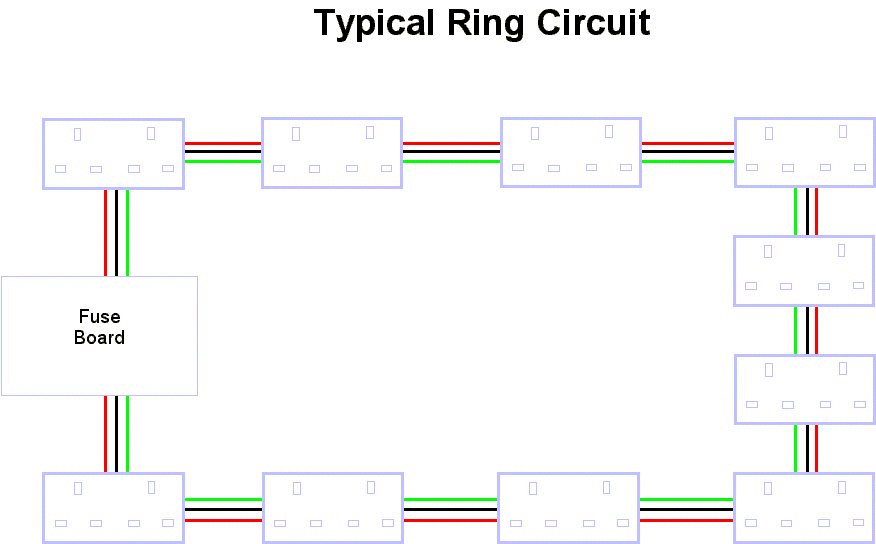
Click image to enlarge
(It will open in a new window)
REMEMBER GREEN REPRESENTS GREEN/YELLOW CONDUCTOR IDENTIFICATION
NEW COLOURS
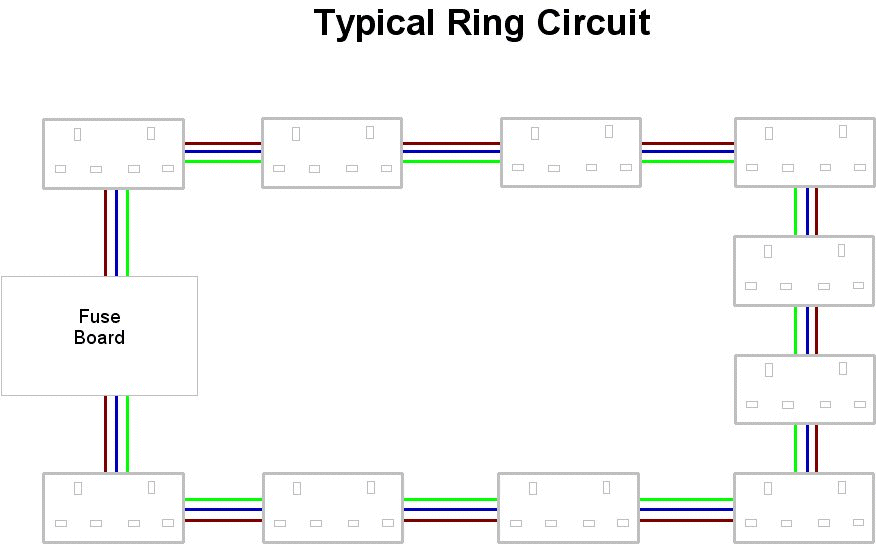
Click image to enlarge
(It will open in a new window)
REMEMBER GREEN REPRESENTS GREEN/YELLOW CONDUCTOR IDENTIFICATION
As previously mentioned, you can add addtional sockets to the ring circuit if they form part of the ring. You can also spur from each socket to one additional socket without providing any additional protection. One spur is permitted for each socket or two gang socket on the ring as shown in the diagram below.
OLD COLOURS
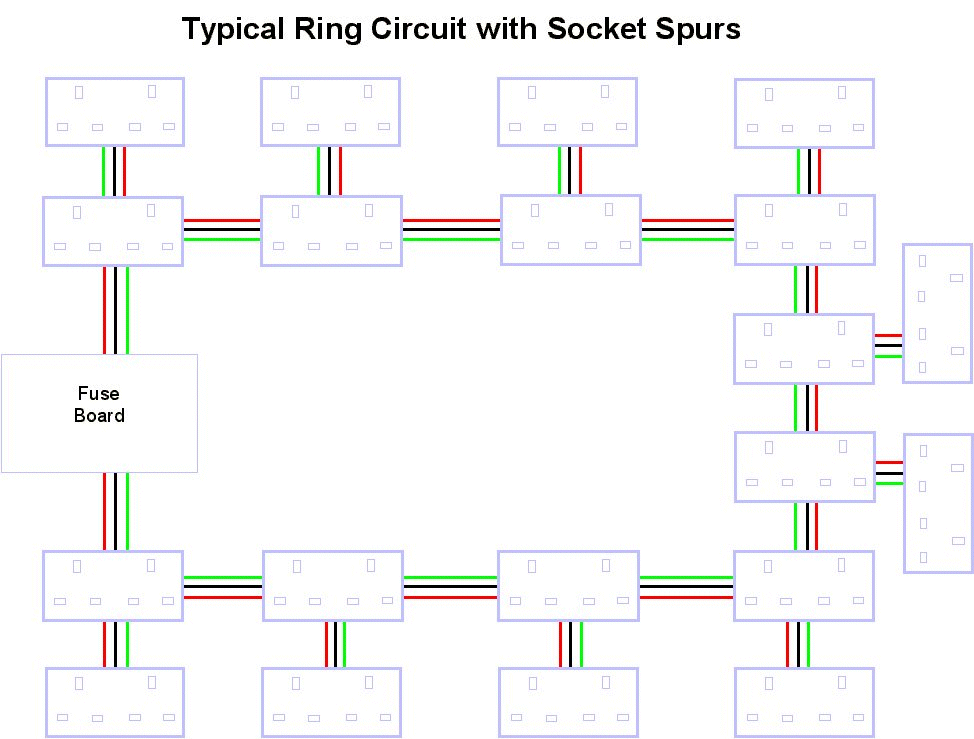
Click on image to enlarge
(It will open a new window)
REMEMBER GREEN REPRESENTS GREEN/YELLOW CONDUCTOR IDENTIFICATION
NEW COLOURS

Click on image to enlarge
(It will open a new window)
REMEMBER GREEN REPRESENTS GREEN/YELLOW CONDUCTOR IDENTIFICATION
It is dangerous to install a spur from a spur unless the cable is of a suitable size that it can be suitably protected by the fuse protecting the circuit. This would require increasing the cable size to 4mm² Twin & Earth CSA. It is not good practice to mix cable sizes if it can be helped. The diagram below shows what NOT TO DO when 2.5mm² Twin and Earth cable is being used.
OLD COLOURS
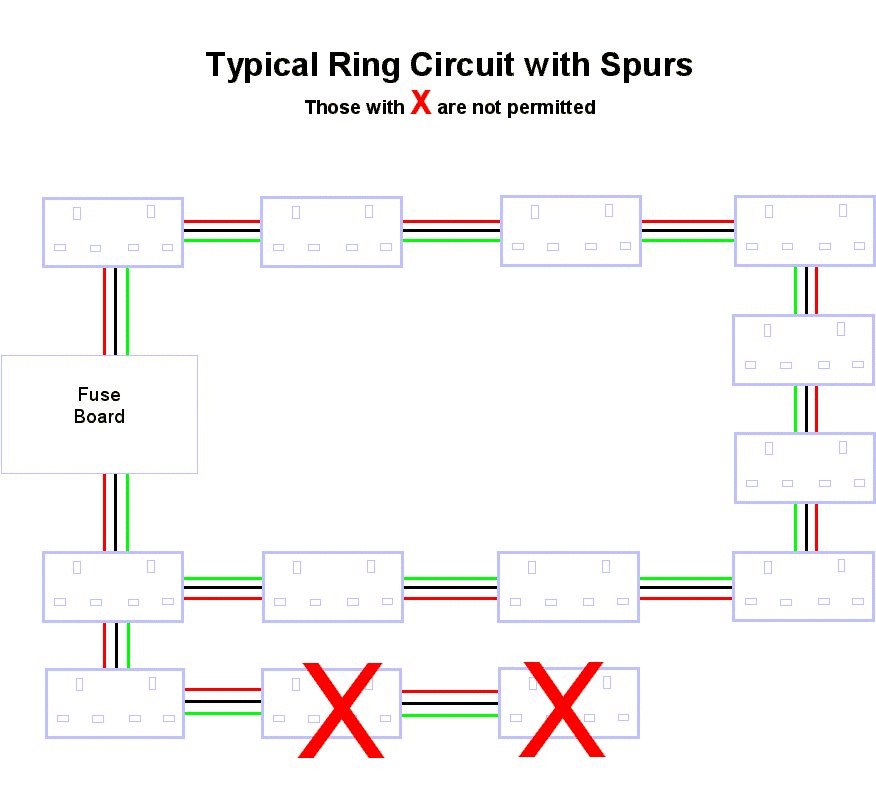
Click image to enlarge
(It will open a new window)
REMEMBER GREEN REPRESENTS GREEN/YELLOW CONDUCTOR IDENTIFICATION
NEW COLOURS
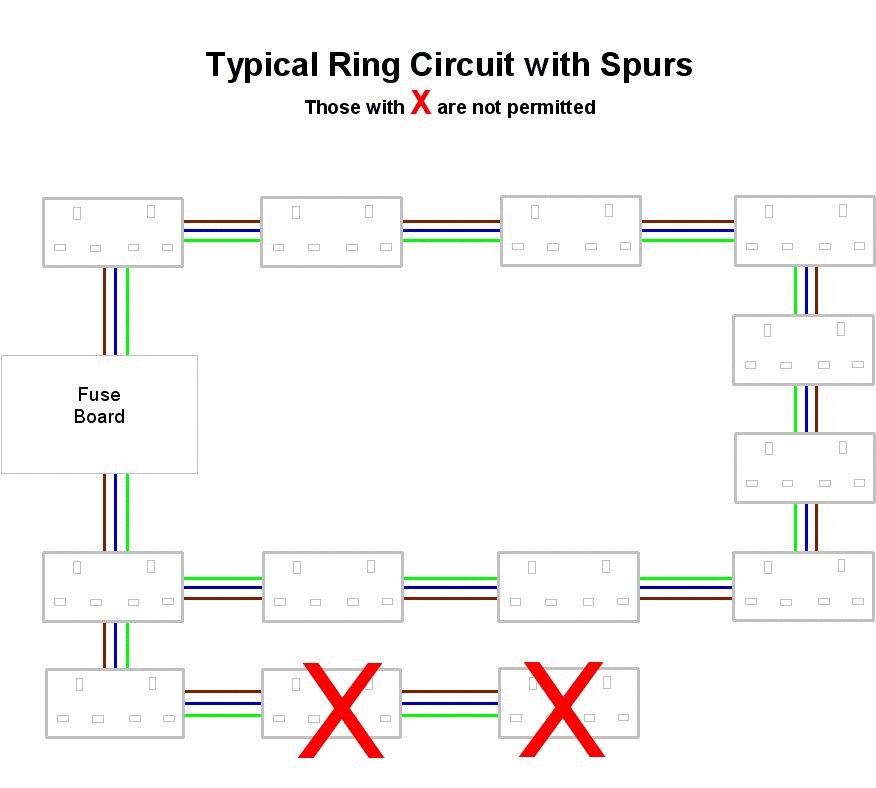
Click image to enlarge
(It will open a new window)
REMEMBER GREEN REPRESENTS GREEN/YELLOW CONDUCTOR IDENTIFICATION
The diagram below shows a spur from a spur using 2.5mm² Twin & Earth CSA with suitable protection that limits the possible load to 13A which is the maximum fuse size that can be installed in a switched or unswitched fused spur. The cable is installed on the output side of the fused spur to protect all the sockets installed further up the circuit.
OLD COLOURS
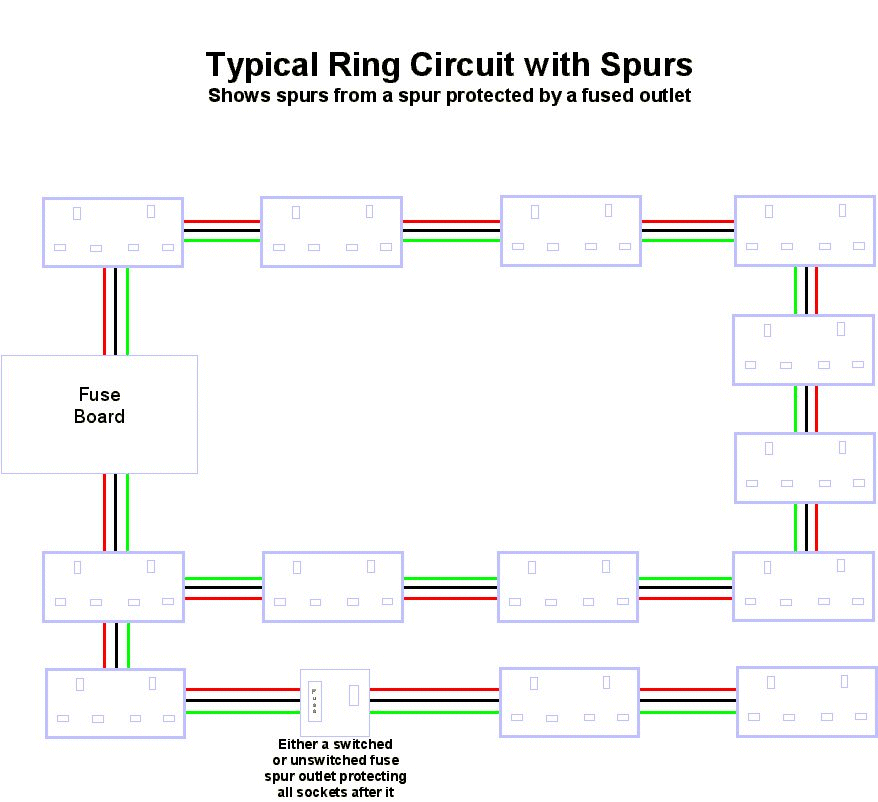
Click on image to enlarge
(It will open in a new window)
REMEMBER GREEN REPRESENTS GREEN/YELLOW CONDUCTOR IDENTIFICATION
NEW COLOURS

Click on image to enlarge
(It will open in a new window)
REMEMBER GREEN REPRESENTS GREEN/YELLOW CONDUCTOR IDENTIFICATION
- Details
There are various types of fans available for the domestic market. The following are a few basic examples:
- Manual
- Timed
- Humidistat
- Combination Timed/Humidistat
- Heat Recovery
The most common place to find an extractor fan at home will be the toilet and/or bathrooms are located. Your choice of fan will depend on:
- the size of room, (different fans will circulate the air more than others)
- whether the room has natural ventilation, (a window that can be opened or not)
- what is to be vented (smells, moisture)
- the voltage you wish to use (ELV, LV)
- where it is to be mounted, (ceiling, loft, wall, shower area)
- Index of protection for the location
Providing power for your fan is reasonably simple as in most cases it is taken from the light circuit. In all cases you will require a local means of isolation by pull cord or by some other means of switching. Local fused protection may be also required depending on the fan and the circuit it is connected to.
Extract Ventalation Rates
| Rooms containing openable windows (that is located on an external wall |
Extract ventilation rates
(litres/second) |
| Kitchen: |
|
| a) adjacent to a hob |
30
|
| b) elsewhere |
60
|
| Utility room |
30
|
| Bathroom (with or without WC) |
15
|
For kitchens, utility room, bathrooms and sanitary accommodation not containing openable windows (that is, internal rooms) requirements will be satisfied if there is either:
a) mechanical extract ventilation rated as in above table and the fan has a 15 minute overrun and is either controlled automatically or manually. in rooms with no natural light it would be appropriate for the fans to be controlled by the operation of the light switch; or
b) passive stack ventilation operated manually and or automatically by sensor or
c) an appropriate open-flued heating appliance.
For items (a) to (c) above, an aire inlet should be provided, for example, a 10mm gap under the door.
Manual Fans
The most basic fan there is either operated by say a light being switched on, integral switching device or a switch located locally just for the fan operation. No matter what means is used to operate the fan, a means of local isolation for servicing purposes should also be fitted.
Standard Timed Fans
Timed fans can be the most awkward to install as power is required from 2 locations, one from the point that switches the light on in the room the fan is to be fitted and a permanent supply as well. When installing local isolation for these you will need to fit a 3 pole switching device so that both sources are isolated. It is not enough to trust isolation by two different switches, e.g. the light switch and another switch installed just for the permanent supply.
PIR Timed Fans
The advantage of this fan over the standard timed fan is that it only requires power from one source. A means of local isolation for servicing purposes should also be fitted.
Humidistat Fans
These are operated by either an integral sensor or remote sensor which detects the humidity level in a room. The sensor is usually adjustable according to the requirements. Some makes provide an integral overide switch so that it operates like a manual fan. There should also be local isolation fitted for servicing.
Combination Timed/Humistat Fans
These should be connected to the power much like the timed fans. The operation of these fans is a combination of the timed and humistat fans. Local isolation should be the same as a timed fan.
Heat Recovery Fans
These are the most expensive, possibly in excess off £200, and instead of venting all the warmth of the room they should recover some of it hence saving money on heating. They come in Manual, Timed, humidistat or combination options. Connection to a power source and local isolation is much the same as in the above fans but exercise caution when deciding your source. These may require a power on their own circuit or consideration may need to be given to taking power from a circuit other than the lights depending on how much power they use.
Typical Extractor Fan Circuit (Old Colours)
(Click on picture to enlarge)
Typical Extractor Fan Circuit (New Colours)
(Click on picture to enlarge)
Subcategories
Design
How to design specific circuits.


